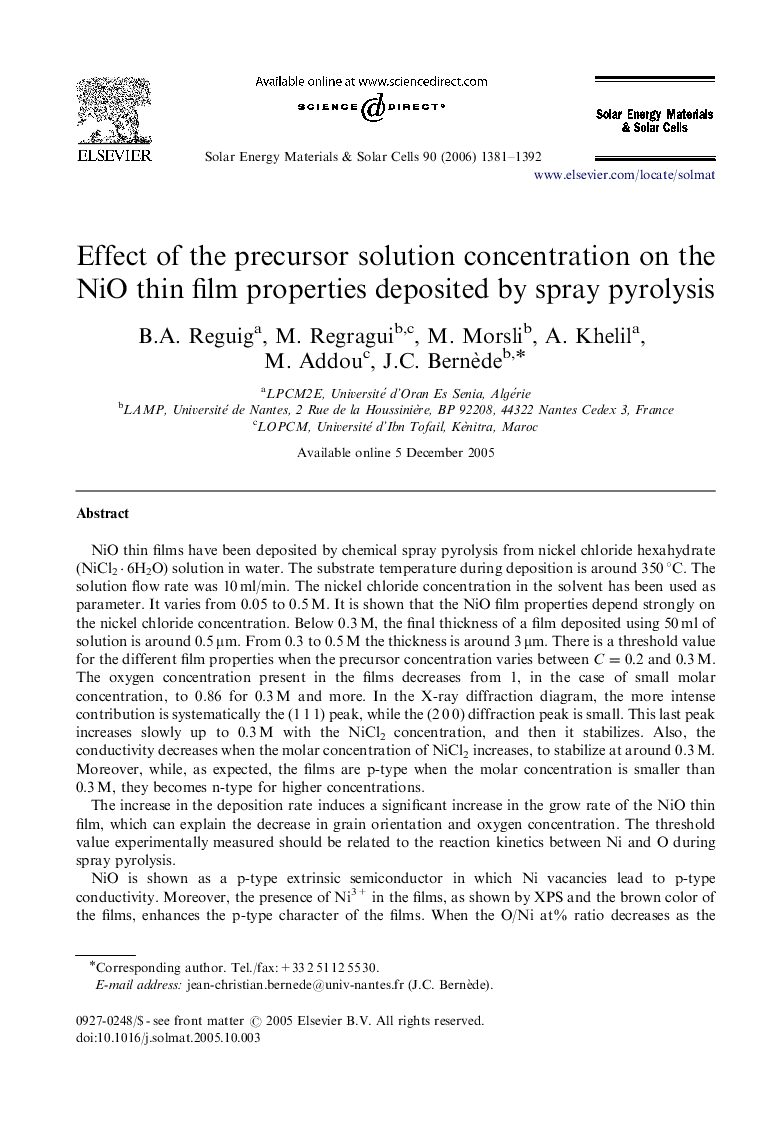| Article ID | Journal | Published Year | Pages | File Type |
|---|---|---|---|---|
| 81250 | Solar Energy Materials and Solar Cells | 2006 | 12 Pages |
NiO thin films have been deposited by chemical spray pyrolysis from nickel chloride hexahydrate (NiCl2·6H2O) solution in water. The substrate temperature during deposition is around 350 °C. The solution flow rate was 10 ml/min. The nickel chloride concentration in the solvent has been used as parameter. It varies from 0.05 to 0.5 M. It is shown that the NiO film properties depend strongly on the nickel chloride concentration. Below 0.3 M, the final thickness of a film deposited using 50 ml of solution is around 0.5 μm. From 0.3 to 0.5 M the thickness is around 3 μm. There is a threshold value for the different film properties when the precursor concentration varies between C=0.2C=0.2 and 0.3M. The oxygen concentration present in the films decreases from 1, in the case of small molar concentration, to 0.86 for 0.3 M and more. In the X-ray diffraction diagram, the more intense contribution is systematically the (1 1 1) peak, while the (2 0 0) diffraction peak is small. This last peak increases slowly up to 0.3 M with the NiCl2 concentration, and then it stabilizes. Also, the conductivity decreases when the molar concentration of NiCl2 increases, to stabilize at around 0.3 M. Moreover, while, as expected, the films are p-type when the molar concentration is smaller than 0.3 M, they becomes n-type for higher concentrations.The increase in the deposition rate induces a significant increase in the grow rate of the NiO thin film, which can explain the decrease in grain orientation and oxygen concentration. The threshold value experimentally measured should be related to the reaction kinetics between Ni and O during spray pyrolysis.NiO is shown as a p-type extrinsic semiconductor in which Ni vacancies lead to p-type conductivity. Moreover, the presence of Ni3+ in the films, as shown by XPS and the brown color of the films, enhances the p-type character of the films. When the O/Ni at% ratio decreases as the precursor concentration increases, the Ni vacancies and, probably, the Ni2O3 concentrations will decrease. Therefore, the hole density should decrease, as also the conductivity and, finally, films becomes n-type.Also, the electrical behavior of the films could be influenced by the chlorine present in the film. There is around 1 at% of chlorine in the films deposited from solutions with small NiCl2 concentration, while there is 2 at% for solutions with high concentration. This element can act as anionic doping in the oxide lattice and substitutes the anion of the oxide, providing an electron in the conduction band which results in n-doping of the lattice.
